Asus U33Jc: Much Ado About Bamboo
by Vivek Gowri on July 29, 2010 9:01 AM ESTASUS U33Jc - Application Performance
I’ll start off with a complaint: ASUS loads waaay too much bloatware on their systems. This came up in the U30Jc review too, but I’ll just reiterate my displeasure here. I really don’t need links to The New York Times, or Amazon’s Kindle Store, or eBay, or any of that other nonsense on my desktop, thanks. It’s not as bad as Sony used to be, but it’s getting there. Some of ASUS’ built in utilities are quite nice, like Power4Gear and the Notebook Hardware Control, but all of the third-party preinstalled software is stuff that needs to be removed immediately. As we showed in our U30 review, it can really kill performance and battery life if left on the system.
Now onto the benchmarks. After our review, ASUS upgraded the processor in the U30Jc to the 2.4GHz Core i3-370M, and the U33 carries that over, along with the Intel HD/Nvidia G310M plus Optimus combo. The U33Jc get’s a larger 500GB hard drive, while the U30 makes do with a 320GB drive, though both are 5400RPM units. Both have 4GB of DDR3 1066. With nearly identical specs, we should expect similar performance from the two.
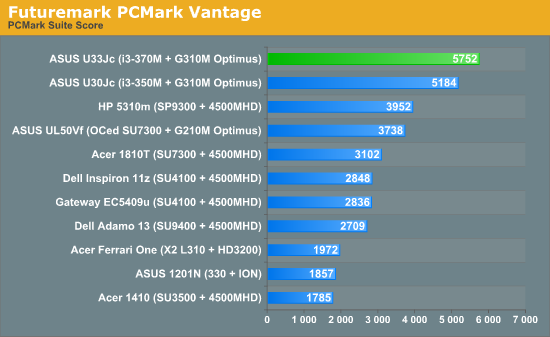
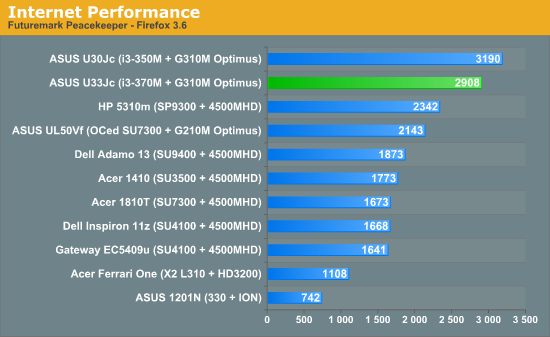
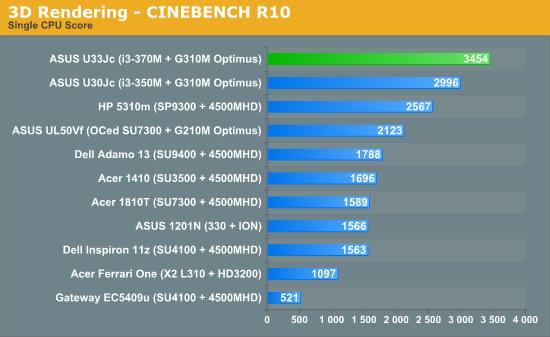
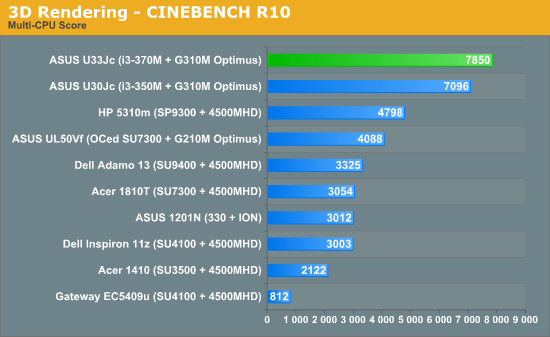
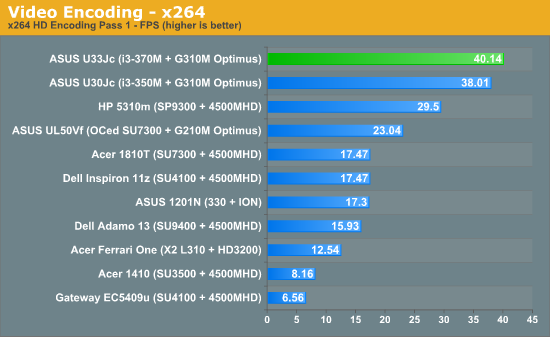

And similar it is. The U33 has slightly better overall processing performance than the U30 test unit we had, which can be attributed to the faster CPU in the U33 (our U30Jc unit was an older SKU that used a 2.26GHz i3-350M). We had some issues with the hard drive tests in PCMark05, but the PCMark Vantage score was a fair bit higher than the U30. We’ll update this section later on with the PCMark05 results, but for right now, the rest of the benchmarks indicate performance on par or slightly better than the U30, which makes the U33Jc the best performing sub-4 pound system right now.










34 Comments
View All Comments
JarredWalton - Thursday, July 29, 2010 - link
I'd guess Apple probably spends about $50 more on their LCD... $100 tops. RGB LED backlit panels are prohibitively expensive, but for standard LED backlighting at a fixed size of 13.3", you're looking at probably $100 for a base panel and $150 for a quality panel. The problem is, most marketing departments are focused on all of the other stuff: you can loudly proclaim better battery life, a faster processor, USB 3.0, etc. but when was the last time you saw a consumer notebook on sale with a sticker that says, "High contrast, high color LCD with an 800:1 contrast ratio!" The closest I've ever come to seeing that is with RBG LED backlighting... which adds ~$150 to $200.Souka - Thursday, July 29, 2010 - link
Too bad on the LCD.I suspect if they had a "+" model which had a better LCD for $100 more they'd sell.
Oh well... my wife's IBM Thinkpad T30 (Pentium 4M cpu) will have to last a bit longer! :)
AnnonymousCoward - Tuesday, August 3, 2010 - link
I agree, Jarred, that it's probably marketing to blame. I hate TN and would always pay for IPS given the choice. Also, 16:9 sucks, as does 768 vertical pixels on a C2D machine.VivekGowri - Thursday, July 29, 2010 - link
While that's true, remember back to before Core 2010 released. The MBP13 was as fast as any of the regular Core 2 Duo notebooks and still had the same screen. So while the current MBP is basically Apple getting away with highway robbery (again), it's not like they can only put in a good display because they're fleecing customers. It's always had a good display. Fair point with the 20% more expensive, but see if you can find me a $1200 13" notebook with a decent display. PC makers just figure to save money with the LCDs in all but the highest end notebooks, which is really disappointing.(The base MacBook is a whole different story - Apple's as guilty as anyone for mediocre quality screens there.)
erple2 - Saturday, July 31, 2010 - link
How's the display on the Envy 14 with the 1600x900 display? That's about 1100 for the "Radiance Display"...PlasmaBomb - Saturday, July 31, 2010 - link
It's supposed to be pretty good, and when the E14 first launched it had the radiance display at $999.crydee - Thursday, July 29, 2010 - link
But I needed a laptop sooner than that. Disappointing this is it after such a long wait. Even on the JTszoxo - Thursday, July 29, 2010 - link
Arguably the most important part of a notebook is the display, since afterall it is the part you stare at, yet manufacturers consistently try to shove these horrible displays down our throats.Stupid glare-type surface, horrible contrast, bad colour representation, terrible black levels, narrow viewing angles. I really don't understand why people buy those things, and some even seem to like them...
Atleast manufacturers now seem to realise that the mirror-like surfaces on the palm rest, keyboard, and bezel are not necessarily good things, and try to move towards matte/textured surfaces.
AstroGuardian - Friday, July 30, 2010 - link
Why would you say that? When being a PRO only thing you care while using the laptop is visible characters and performance. Why would it be crucial for the display to be high quality? Display is a display. On that kind of computer it's enough for the display to be clear and illuminated. But i agree with the fact that 1366x762 is a lousy resolutionzoxo - Friday, July 30, 2010 - link
When I work on a computer, and look at the screen, I want to see what's on the screen, not my reflection/the window or whatever is behind me. I want to actually be able to distinguish red from orange, black from gray. I think a screen is extremely important when you want to look at it for more than 10 minutes at a time.